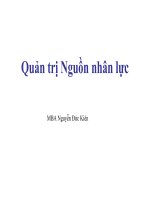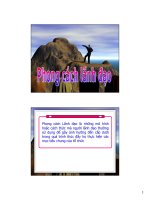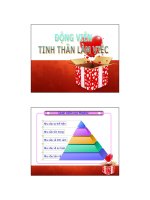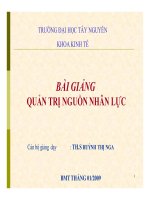Bài giảng QUản trị nguồn nhân lực part 4 eng
Bạn đang xem bản rút gọn của tài liệu. Xem và tải ngay bản đầy đủ của tài liệu tại đây (1.04 MB, 78 trang )
Human Resource Management
Session 4
SELECTION
1
HRM in Action – Credential Fraud
Applicants may exaggerate their skills,
education / qualifications, and experience.
A recent study found that 44% of employment
records showed a difference of information
between what the applicant provided and the
previous employer reported.
Others may neglect to provide details of their
criminal history – 12.6%
One HR Manager said, “10% to 20% of
applicants flat out lie”.
-2
Selection
• Process of choosing from group of applicants
the individual best suited for a particular position
and the organization
• Top performers contribute from 5-22 times more
value to companies than mid-level or low
performers
• Goal of selection process is to properly match
people with jobs and the organisation. A bad fit
means the person will be ineffective and
probably leave the firm, voluntarily or otherwise.
3
Environmental Factors Affecting
the Selection Process
1. Other HR functions
2. Legal considerations
3. Decision making speed
4. Organizational hierarchy
5. Applicant pool
6. Type of organization
7. Probationary period
4
1. Other HR Functions
Selection
process affects,
and is affected
by, virtually every
other HR
function.
5
2. Legal Considerations
• Human resource management is greatly
influenced by legislation, executive
orders, and court decisions
• Guiding principle – “Why am I asking this
question?”
• If information is job related, usually asking
for the information is appropriate
6
3. Speed of Decision Making
Time available to
make selection
decision can have
major effect on
selection process
7
4. Organizational Hierarchy
Different
approaches to
selection are
generally taken for
filling positions at
different levels in
organization
6-8
4. Organizational Hierarchy (Cont.)
• Extensive background checks and multiple
interviews would most likely apply for the
executive position
• An applicant for a clerical position would
probably take a word processing test and
perhaps have a short employment
interview
• What about a Driver for your company car?
9
5. Applicant Pool
• Number of qualified applicants recruited
for a particular job
• Selection ratio is the number of people
hired for a particular job compared to
number of individuals in the applicant pool
• Selection ratio of 0.10 indicates that there
were 10 qualified applicants for an open
position
10
6. Type of Organization
• Prospective employees in private sector
screened with regard to how they can help
achieve profit goals
• Government civil service systems identify
qualified applicants through competitive
examinations
• Individuals considered for positions in notfor-profit organizations must be qualified
and dedicated to work
© 2008 by Prentice Hall
6-11
7. Probationary Period
• Period that permits
evaluating employees
ability based upon
performance
• May be a substitute for
certain phases of the
selection process
• Newly hired employees
need monitoring
12
The Selection Process
External Environment
Internal Environment
Recruited Candidate
2. Review of Applications and Résumés
3. Selection Tests
4. Employment Interviews
5. Pre-Employment Screening:
Background and Reference Checks
Rejected Applicants
1. Preliminary Interview
6. Selection Decision
7. Physical Examination
New Employee
13
1. The Preliminary Interview
• Narrow pool of applicants before having
formal face-to-face interview: reduces
wasted time and effort by removing
unqualified individuals
• Positive benefits - Applicant may be
better qualified for another position with
the firm
14
1. The Preliminary Interview (cont.)
• Methods:
Telephone Interview - Lacks advantages of faceto-face contact. Not possible to observe nonverbal cues
Videotape Interview - Using structured interview
format designed by hiring firm, interviewer can
videotape candidate’s responses. Interviewer
may not interact with the candidate. Does not
replace personal interviews. Allows for broader
search
15
2. Review of Applications
• Application form must reflect not only firm’s
informational needs, but also EEO (equal
employment opportunity) requirements.
• Essential information is included and presented
in standardized format
• May vary from firm to firm, and even by job type
within organization
• Applications for some posts, management/
professional, may require a resume (CV) instead
or possibly as well.
See Figures 6-2 and 6-3 for examples of application form
and resume (CV)
16
2. Review of Applications (cont.)
Preprinted Statements on Application Form
• Certifies that information
provided on form is accurate
and true
• Should state position is
employment at will
• Gives permission to have
background and references
checked
17
3. Review of Résumés (CVs)
• Résumé - Goal-directed summary of experience,
education, and training developed for use in
selection process
• Professional/managerial applicants often begin
selection process by submitting résumé
• Includes career objective for specific position
• All important concept of relevancy – it must be
tailored for each and every application. A ‘general’
CV is unlikely to have the desired effect.
18
Sending Résumés via the Internet
• Most large companies now use automated
tracking systems
• Résumés deviating from assumed style
are ignored
• Résumé should be as computer/scanner
friendly as possible
19
Keyword Résumé
• Keywords - Words or phrases used to
search databases
• Keyword résumé - Adequate description
of job-seeker’s characteristics and
industry-specific experience presented
in keyword terms to accommodate the
computer search process
20
Additional Recommendations
• Avoid special characters.
• Do not use tabs; use space bar.
• Do not use word-wrap feature; use hard returns
to insert line breaks.
• Use default font and size.
• Do not use boldface and italics.
• Do not use blocks.
• Do not use columns.
• Do not place names or lines on sides of résumés
21
3. Administration of Selection Tests
• Advantages
• Potential Problems using Selection
Tests
• Characteristics of Properly Designed
Selection Tests
22
Advantages of Selection Tests
• Reliable and accurate
means of selecting qualified
candidates
• Cost small in comparison
• Identify attitudes and jobrelated skills that interviews
cannot recognize
23
Potential Problems Using
Selection Tests
• Can do v. Will do
• Legal liabilities
• Test anxiety
24
Characteristics of Properly
Designed Selection Tests
• Standardization - Uniformity of
procedures and conditions of
administering test
• Objectivity - Everyone scoring a test
obtains same results
• Norms - Frame of reference for
comparing applicant's performance
with that of others
25









